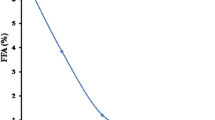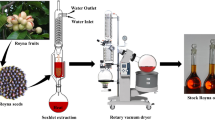Abstract
Biodiesel production from non-edible feedstocks is currently drawing much attention due to legitimate concerns about the effects of using edible oil for fuel. Pangium edule Reinw is a non-edible feedstock. Pangium is a tall tree native to the Micronesia, Melanesia and the mangrove swamps of South-East Asia. In this study, biodiesel production and characterization from P. edule oil was reported. The seeds were obtained from Bogor, Indonesia. The oil was found to have an acid value of 19.62 mg KOH/g oil. Therefore, a two-step acid–base-catalysed transesterification was used to produce biodiesel. This was followed by evaluating the physical and chemical properties of biodiesel and its blends with diesel. It has been found that the determined properties of P. edule methyl ester indicate that the oil can be considered as a future biodiesel source. The most remarkable feature of P. edule is its cloud, pour and cold filter plugging points. This biodiesel yielded cloud, pour and cold filter plugging points of –6, –4 and –8 °C, respectively. This indicates the viability of using this biodiesel in cold countries. Therefore, it is suggested that more research should be conducted on P. edule for future biodiesel production.
Similar content being viewed by others
Abbreviations
- CCMO:
-
Crude Croton megalocarpus L. oil
- CIME:
-
Calophyllum inophyllum methyl ester
- CMOO:
-
Crude Moringa oleifera L. oil
- CN:
-
Cetane number
- COME:
-
Coconut methyl ester
- CPEO:
-
Crude Pangium edule oil
- CPO:
-
Crude palm oil
- CSO:
-
Crude soybean oil
- EPEO:
-
Esterified Pangium edule oil
- IV:
-
Iodine value
- JCME:
-
Jatropha curcas methyl ester
- MOME:
-
Moringa oleifera methyl ester
- PME:
-
Palm oil methyl ester
- PEME:
-
Pangium edule methyl ester
- SN:
-
Saponification number
- SME:
-
Soybean methyl ester
References
Kafuku G., Mbarawa M.: Biodiesel production from Croton megalocarpus oil and its process optimization. Fuel 89(9), 2556–2560 (2010)
No S.Y.: Inedible vegetable oils and their derivatives for alternative diesel fuels in CI engines: a review. Renew. Sustain. Energy Rev. 15(1), 131–149 (2011)
Atabani A.E., Silitonga A.S., Badruddin I.A., Mahlia T.M.I., Masjuki H.H., Mekhilef S.: A comprehensive review on biodiesel as an alternative energy resource and its characteristics. Renew. Sustain. Energy Rev. 16(4), 2070–2093 (2012)
Singh S.P., Singh D.: Biodiesel production through the use of different sources and characterization of oils and their esters as the substitute of diesel: a review. Renew. Sustain. Energy Rev. 14(1), 200–216 (2010)
Silitonga A.S., Atabani A.E., Mahlia T.M.I., Masjuki H.H., Badruddin I.A., Mekhilef S.: A review on prospect of Jatropha curcas for biodiesel in Indonesia. Renew. Sustain. Energy Rev. 15, 3733–3756 (2011)
Demirbas A.: Biodiesel production from vegetable oils via catalytic and non-catalytic supercritical methanol transesterification methods. Prog. Energy Combust. Sci. 31(5-6), 466–487 (2005)
Demirbas A.: Biofuels: Securing the Planet’s Future Energy Needs. Springer, London (2009)
Kumar A., Sharma S.: Potential non-edible oil resources as biodiesel feedstock: an Indian perspective. Renew. Sustain. Energy Rev. 15(4), 1791–1800 (2011)
Moser B.R., Vaughn S.F.: Coriander seed oil methyl esters as biodiesel fuel: unique fatty acid composition and excellent oxidative stability. Biomass Bioenergy 34(4), 550–558 (2010)
Atabani A.E., Mofijur M., Masjuki H.H., Badruddin I.A., Kalam M.A., Chong W.T.: Effect of Croton megalocarpus, Calophyllum inophyllum, Moringa oleifera, palm and coconut biodiesel–diesel blending on their physico-chemical properties. Ind. Crops Prod. 60, 130–137 (2014)
Gui M.M., Lee K.T., Bhatia S.: Feasibility of edible oil vs. non-edible oil vs. waste edible oil as biodiesel feedstock. Energy 33(11), 1646–1653 (2008)
Balat M.: Potential alternatives to edible oils for biodiesel production: a review of current work. Energy Convers. Manag. 52(2), 1479–1492 (2011)
Chakraborty M., Baruah D.C., Konwer D.: Investigation of terminalia (terminalia belerica Robx) seed oil as perspective biodiesel source for North-East India. Fuel Process. 90(12), 1435–1441 (2009)
Rashid U., Anwar F., Moser B.R., Knothe G.: Moringa oleifera oil: a possible source of biodiesel. Bioresour. Technol. 99(17), 8175–8179 (2008)
Kansedo J., Lee K.T., Bhatia S.: Cerbera odollam (sea mango) oil as a promising non-edible feedstock for biodiesel production. Fuel 88(6), 1148–1150 (2009)
Sarin R., Sharma M., Khan A.A.: Studies on Guizotia abyssinica L. oil: biodiesel synthesis and process optimization. Bioresour. Technol. 100(18), 4187–4192 (2009)
Atabani A.E., Silitonga A.S., Ong H.C., Mahlia T.M.I., Masjuki H.H., Badruddin I.A., Fayaz H.: Non-edible vegetable oils: a critical evaluation of oil extraction, fatty acid compositions, biodiesel production, characteristics, engine performance and emissions production. Renew. Sustain. Energy Rev. 18, 211–245 (2013)
Atabani A.E., da Silva César A.: Calophyllum inophyllum L.—a prospective non-edible biodiesel feedstock. Study of biodiesel production, properties, fatty acid composition, blending and engine performance. Renew. Sustain. Energy Rev. 37, 644–655 (2014)
Nofiarl K.A., Nurdin H.: The biodiesel characteristic of kepayang oil (Pangium edule reinw.). ARPN J. Agric. Biol. Sci. 8(3), 241–244 (2013)
Discover Life. 2013 [cited 2014 5th May]; Available from: http://www.discoverlife.org/mp/20m?map=Pangium+edule
University of Guam. Panguim Edule. 2012 [cited 2014 25th April]; Available from: http://university.uog.edu/cals/people/POG/pangium.html
Andarwulan N., Fardiaz S., Apriyantono A., Hariyadi P., Shetty K.: Mobilization of primary metabolites and phenolics during natural fermentation in seeds of Pangium edule Reinw. Process Biochem. 35(1-2), 197–204 (1999)
The Archieves of The Rare Fruit Council of Australia. The football fruit. 2013 [cited 2014 4th May]; Available from: http://rfcarchives.org.au/Next/Fruits/Pangium/Pangium11-97.htm
Atabani A.E., Mahlia T.M.I., Anjum Badruddin I., Masjuki H.H., Chong W.T., Lee K.T.: Investigation of physical and chemical properties of potential edible and non-edible feedstocks for biodiesel production, a comparative analysis. Renew. Sustain. Energy Rev. 21(0), 749–755 (2013)
Atabani A.E., Mahlia T.M.I., Masjuki H.H., Badruddin Irfan Anjum, Yussof Hafizuddin Wan, Chong W.T., Lee Keat Teong: A comparative evaluation of physical and chemical properties of biodiesel synthesized from edible and non-edible oils and study on the effect of biodiesel blending. Energy 58, 296–304 (2013)
Devan P.K., Mahalakshmi N.V.: Study of the performance, emission and combustion characteristics of a diesel engine using poon oil-based fuels. Fuel Process. Technol. 90(4), 513–519 (2009)
Mohibbe Azam M., Waris A., Nahar N.M.: Prospects and potential of fatty acid methyl esters of some non-traditional seed oils for use as biodiesel in India. Biomass Bioenergy 29(4), 293–302 (2005)
Mofijur M., Masjuki H.H., Kalam M.A., Atabani A.E.: Evaluation of biodiesel blending, engine performance and emissions characteristics of Jatropha curcas methyl ester: Malaysian perspective. Energy 55, 879–887 (2013)
Sahoo P.K., Das L.M., Babu M.K.G., Naik S.N.: Biodiesel development from high acid value polanga seed oil and performance evaluation in a CI engine. Fuel 86(3), 448–454 (2007)
Sanford, S.D., White, J.M., Shah, P.S., Wee, C., Valverde, M.A., Meier, G.R.: Feedstock and Biodiesel Characteristics. 2011 [cited 2014 4th May]; Available from: http://www.regfuel.com/pdfs/Feedstock%20and%20Biodiesel%20Characteristics%20Report.pdf.
Knothe G.: Dependence of biodiesel fuel properties on the structure of fatty acid alkyl esters. Fuel Process. Technol. 86(10), 1059–1070 (2005)
Giakoumis E.G.: A statistical investigation of biodiesel physical and chemical properties, and their correlation with the degree of unsaturation. Renew. Energy 50, 858–878 (2013)
Author information
Authors and Affiliations
Corresponding author
Rights and permissions
About this article
Cite this article
Atabani, A.E., Badruddin, I.A., Masjuki, H.H. et al. Pangium edule Reinw: A Promising Non-edible Oil Feedstock for Biodiesel Production. Arab J Sci Eng 40, 583–594 (2015). https://doi.org/10.1007/s13369-014-1452-5
Received:
Accepted:
Published:
Issue Date:
DOI: https://doi.org/10.1007/s13369-014-1452-5




